Last Updated on October 30, 2025 by teamobn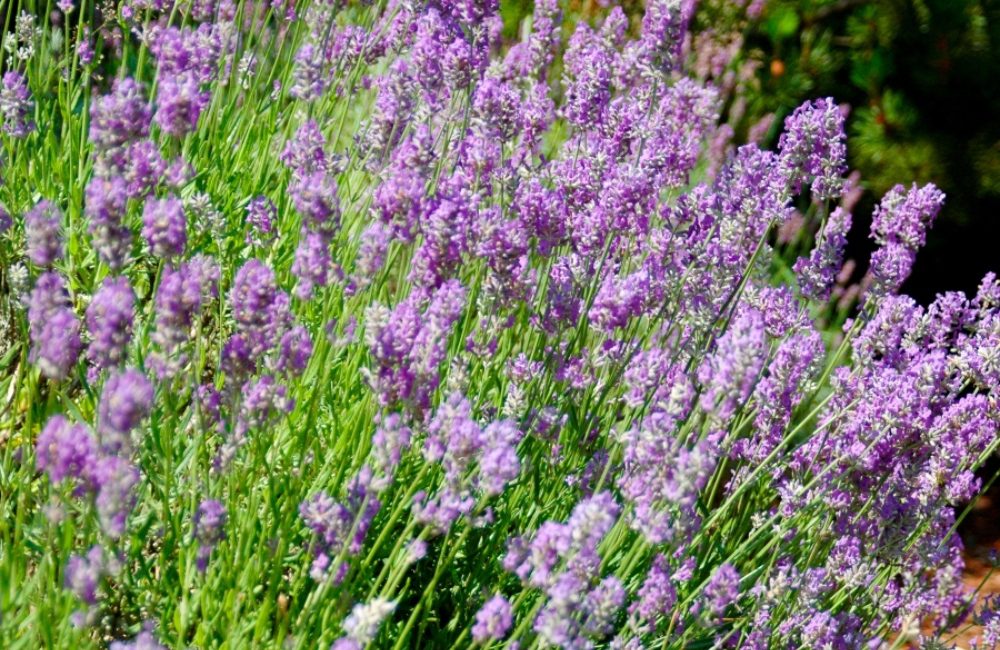
Want a garden that looks good without wasting water? You’re in luck. A drought-tolerant garden saves you money and is easy to care for. It’s a smart choice for home builders and renovators looking to boost their outdoor space.
Before you choose plants and layout, take a quick look at these front yard landscaping ideas to anchor your design — they’ll help make your drought-tolerant choices fit the whole yard.
Ready to make your yard the talk of the neighborhood? Keep reading to find out how.
Contents
Why Go for a Drought-Tolerant Garden
Why go for a garden that needs less water? The reasons are plenty. First off, you save money. Water isn’t cheap. A garden that drinks less saves you more on your bills.
Next, think about time. Traditional gardens need a lot of it. You water, you prune, you worry. But drought-tolerant plants are low-maintenance. They don’t ask for much. You spend less time with the hose and more time enjoying your space.
Now, let’s talk about the planet. Water is a resource we need to protect. Droughts are happening more often. Less water in your garden means more water for everyone else. It’s a simple step with a big impact.
Don’t forget curb appeal. Some people think a drought-tolerant garden means dull. That’s not true. These gardens can be beautiful. Picture succulents with vibrant colors. Think of herbs that smell amazing. These plants have personalities.
But what about the value of your home? Outdoor spaces matter to buyers. A drought-tolerant garden is a selling point. It tells buyers you care. It also shows you think ahead. People like that. It could make your home sell faster and for more money.
Last but not least, it’s fun. Choosing plants for your drought-tolerant garden is an adventure. Designing the layout gets your creative juices flowing. You get to make something that’s yours.
Convinced yet? A drought-tolerant garden is a win-win. It saves you money and time. It helps the planet. And it could even boost your home’s value. Why wouldn’t you make the switch?
Choosing the Right Location
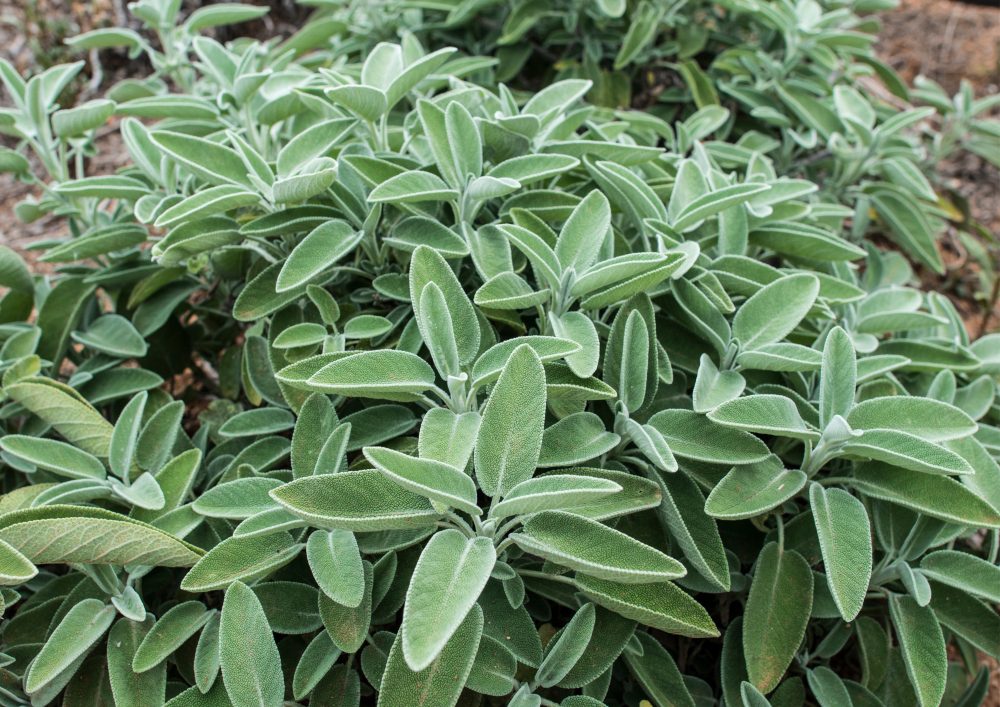
Ready to start your drought-tolerant garden? The first step is choosing the right spot. A good location sets you up for success.
Soil and Drainage
Good soil is the foundation of any drought-tolerant garden. For drought-tolerant plants, drainage is key. You don’t want water to sit. It should flow away. Bad drainage can rot the roots. How do you test it? Water the area. See how fast it drains. Slow drainage is a no-go. Improve your soil with compost. Compost helps with drainage. It also feeds your plants. Sand is another option. It helps water move through the soil. Get your soil right, and your garden will thank you.
Sunlight and Shade
Sunlight is a big deal for every drought-tolerant garden. Most drought-tolerant plants love the sun. Aim for at least six hours a day. But don’t forget shade. Some shade is good, especially in hot climates. Too much sun can stress plants. The morning sun is gentler than the afternoon sun. Position your plants carefully. Taller plants can give smaller ones some shade. This helps everyone stay happy.
Space and Layout
Think about space of your drought-tolerant garden. Plants need room to grow. Check the tags when you buy plants. They’ll tell you how much space each one needs. Don’t cram them in. They’ll compete for water and nutrients. Leave enough room for air to circulate.
This prevents disease. Plan your layout before you plant. Put taller plants in the back. Smaller ones go in the front. This way, all plants get sunlight. A good layout makes your garden look better and grow better.
Nearness to Home
Don’t make reaching your garden a trek. Your drought-tolerant garden should be close to your house. Easy access means you’ll take better care of it. Plus, you’ll enjoy it more. You might skip if you have to walk far to water or prune. That’s not good for the garden.
Being near your garden also lets you spot problems early, like pests or dry soil. It’s also more enjoyable to look out your window and see your beautiful garden nearby.
Picking the right location is crucial. Get it right, and your drought-tolerant garden will thrive. Now you know what to look for.
Soil Preparation
Got your spot picked out for your drought-tolerant garden? Great! Now, let’s prep the soil. Good soil makes your garden grow strong and look great.
Testing the Soil
Before you plant anything, know your soil. It’s the first step to a successful drought-tolerant garden. You can buy a soil test kit from a garden store. This kit tells you the pH level and nutrient content. Why does this matter? Different plants like different soils. Most drought-tolerant plants prefer well-drained, loamy soil. Some like it a bit sandy. Your soil test will guide you.
After testing your drought-tolerant garden, you might find your soil too acidic or alkaline. Don’t worry. You can fix it. To raise the pH, use lime. To lower the pH, use sulfur. Follow the instructions on the package. Then, test again to make sure it’s right.
Understanding your soil also helps with watering. Clay soil holds water longer. Sandy soil drains fast. Knowing this enables you to water just the right amount. No more guessing. You’re set up for success from the start.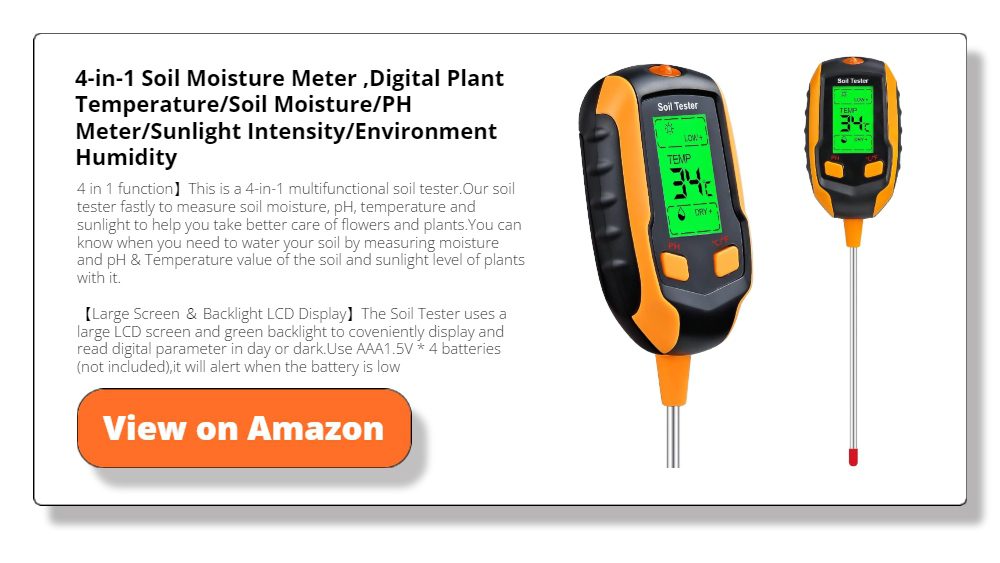
Adding Organic Matter
Compost is your drought-tolerant garden’s best friend. It improves almost any type of soil. Organic matter like compost makes soil richer. It helps retain moisture but still drains well. This is perfect for drought-tolerant plants. They get the water they need without drowning.
Adding compost is easy. Spread a thick layer over your drought-tolerant garden area. Then, mix it in with the existing soil. Make sure it’s well-blended. You can also add other organic matter. Think aged manure or leaf mold. They also improve soil quality.
What if you don’t have compost? You can buy it. Or make your own. Use kitchen scraps like fruit and veggie peels. Add yard waste like leaves and grass clippings. You’ll have rich compost ready for your garden in a few months.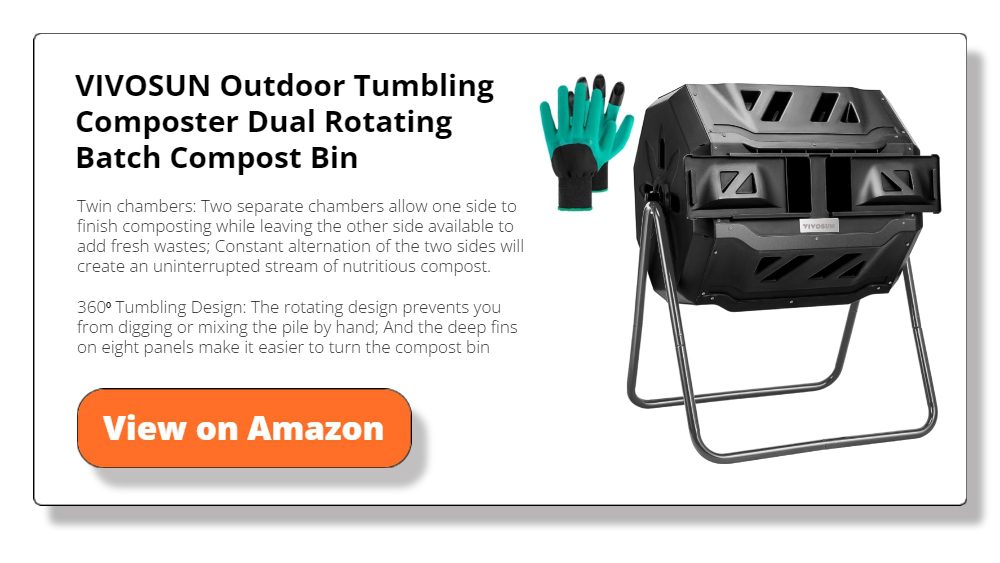
Improving Drainage
Drainage is a big deal for drought-tolerant gardens. Plants don’t like wet feet. Bad drainage can lead to root rot. So, how do you improve it? First, check your soil type. Sandy soil usually drains well. Clay soil, not so much.
If you have clay soil, don’t lose hope. You can improve it. Add sand and organic matter. They help water move through the soil. Another option is a raised bed. This lifts the soil above ground level. It helps water drain away from plant roots.
You can also use gravel at the bottom of planting holes. This gives water an escape route. Or dig ditches to channel water away from the garden. There are many ways to get it right. Choose what works best for you. Now, your plants will grow strong, not soggy.
Well-prepared soil is a game changer. It sets the stage for a lush, low-water garden. Now that your soil is ready, you can pick the best plants.
Selecting Plants
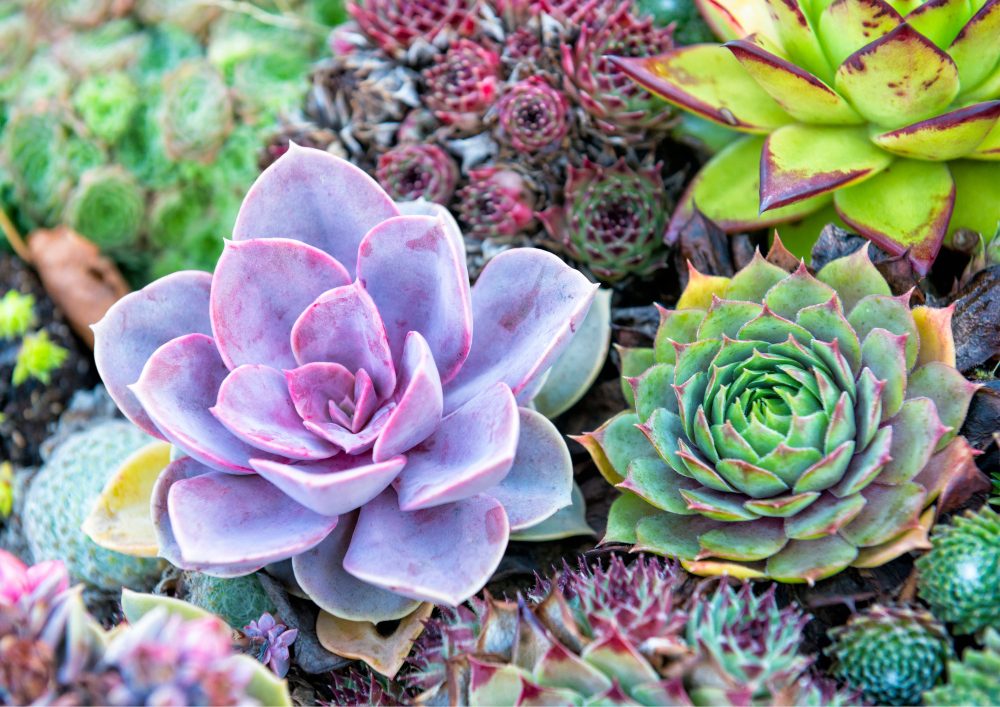
Your soil is ready. Your spot is picked. Now comes the fun part: picking your plants. Choose the right ones, and you’ll have a beautiful, water-wise garden.
Lavender
Lavender is known for its purple flower spikes. It grows about 1 to 3 feet tall. The plant gives off a strong, soothing scent.
Why It’s Great:
Lavender is tough. It can handle hot, dry climates. It needs little water once it’s established.
Growing Tips:
Plant it in well-drained soil. Full sun is best. It doesn’t need much fertilizer. Prune it after it blooms to keep it neat.
Sage
Sage has grey-green leaves and purple, blue, or white flowers. It can grow up to 2 feet tall. The leaves have a strong, earthy scent.
Why It’s Great:
Sage is a great choice for drought-tolerant gardens. It likes dry soil and can handle full sun.
Growing Tips:
Plant sage in well-drained soil. It likes sunny spots. You don’t need to water it much. Light pruning helps it keep its shape.
Succulents
Succulents come in many shapes and sizes. Some have thick, fleshy leaves. Others have long, trailing stems. They can be green, pink, or even purple.
Why It’s Great:
Succulents store water in their leaves. This makes them perfect for dry climates. They need very little water.
Growing Tips:
Plant them in sandy, well-drained soil. They like the sun but can handle some shade. Be careful not to overwater. Too much water can make them rot.
Ornamental Grasses
Ornamental grasses come in various sizes and colors. They can be tall and wispy or short and compact. Most don’t have a strong scent.
Why It’s Great:
These grasses are tough. They can thrive in hot, dry conditions. Most types don’t need a lot of water.
Growing Tips:
Plant in well-drained soil. Most prefer full sun. They don’t need much care. Just cut them back once a year.
Yarrow
Yarrow has feathery leaves and small, clustered flowers. The flowers can be yellow, white, or pink. It grows up to 3 feet tall. No strong aroma here.
Why It’s Great:
Yarrow is a good fit for drought-tolerant gardens. It can handle dry soil and loves the sun.
Growing Tips:
Plant in well-drained soil in a sunny spot. It doesn’t need much care. Trim the dead flowers to encourage new growth.
Rosemary
Rosemary has needle-like leaves and blue flowers. It can grow up to 4 feet tall. The leaves have a strong, piney scent.
Why It’s Great:
Rosemary is hardy. It likes dry, hot climates. Once it’s established, it needs very little water.
Growing Tips:
Plant it in well-drained soil. Full sun is best. You don’t need to fertilize often. Prune it to keep it tidy.
Agave
Agave has thick, fleshy leaves that end in sharp points. It can grow quite large, up to 5 feet across. It doesn’t have a strong scent.
Why It’s Great:
Agave is perfect for a drought-tolerant garden. It stores water in its leaves. It’s used in dry, hot climates.
Growing Tips:
Plant agave in sandy, well-drained soil. It likes full sun. Be careful when planting; those points are sharp! Water sparingly to avoid rot.
Thyme
Thyme is a low-growing herb with tiny leaves. It has small pink or white flowers. The leaves have a mild, earthy scent.
Why It’s Great:
Thyme is ideal for drought-tolerant gardens. It needs little water and loves the sun.
Growing Tips:
Plant thyme in well-drained soil. Pick a sunny spot. Water it sparingly. Pruning isn’t needed much, just to shape.
Zinnia
Zinnias are colorful flowers. They come in many colors, like red, pink, and orange. They can grow from 1 to 3 feet tall. There is no strong smell here.
Why It’s Great:
Zinnias are great for dry gardens. They like the heat and don’t need much water.
Growing Tips:
Plant them in well-drained soil. They like full sun. Deadhead the old flowers to get more blooms. No need for much fertilizer.
Oregano
Oregano has small, round leaves and tiny white or purple flowers. It grows about 1 to 2 feet tall. The leaves smell like pizza or spaghetti sauce.
Why It’s Great:
Oregano is easy to grow in dry conditions. It doesn’t need much water or care.
Growing Tips:
Plant it in well-drained soil. A sunny spot is best. It doesn’t need much watering or feeding. Trim it back to keep it tidy.
Choosing plants for a drought-tolerant garden doesn’t mean sacrificing beauty or variety. You’ve got options. Many options. So start planting and enjoy a garden that’s as easy on the eyes as on your water bill.
Planting Tips
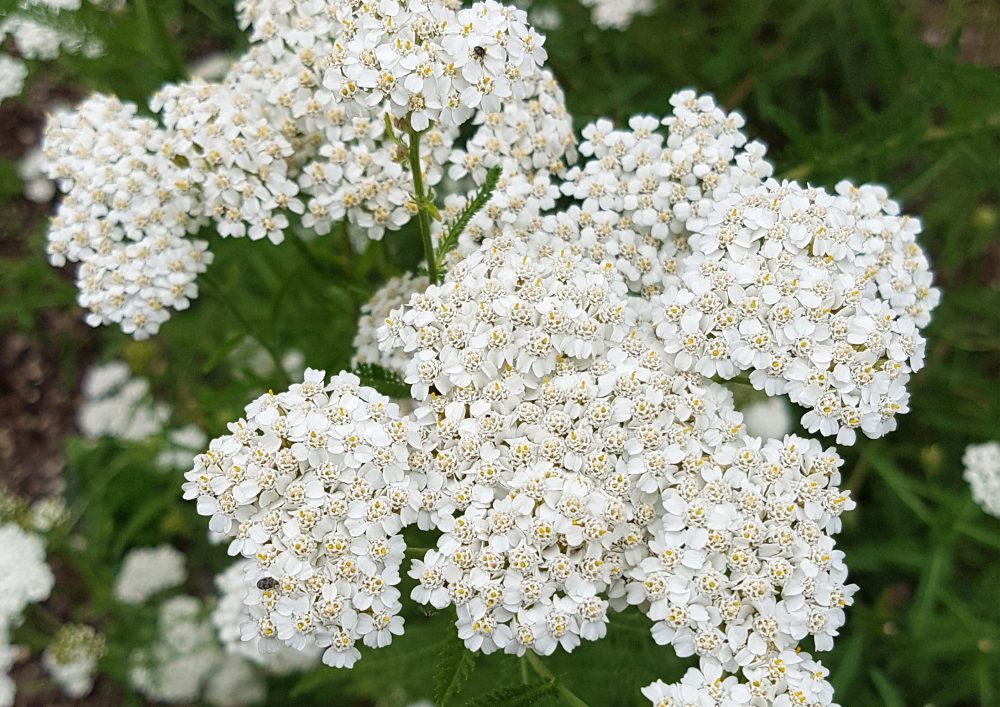
You’ve got your soil and plants ready. Now, it’s time to get them in the ground. These tips will help you plant like a pro.
Dig the Right Hole
A hole too shallow or too deep spells trouble. Dig it just right for healthy roots. The hole should be twice as wide as the plant’s root ball. But no more profound than the root ball height. Why? Wide holes give roots room to grow. But too deep, and the plant might rot.
Once you dig the hole, rough up the sides. This makes it easier for roots to move through the soil. Before you put the plant in, water the hole. This helps settle the soil and removes air pockets.
Now, put the plant in. Fill the hole half-way with soil. Water again. Then, fill the rest of the hole. This step-by-step method gives your plants a strong start.
Space Them Out
Spacing matters. Plants need room to grow and breathe. Check the plant tag or ask at the garden store. It’ll tell you how far apart to place your plants.
Too close, and they’ll compete for nutrients and water. Too far, and your garden might look sparse. Proper spacing also helps with airflow. Good airflow means less disease. So measure before you plant. Get it right from the start.
Water Deeply at First
Even drought-tolerant plants need extra water at the start. Deep watering helps roots grow down, not out. How do you do it? Soak the soil. Wait. Soak it again.
The goal is moist, not soggy soil. Use a long hose or watering can to reach all plants. Do this for the first few weeks. Then you can cut back. Deep watering at the start means less watering later.
Watch for Weeds
Weeds steal water and nutrients. Don’t let them take over. Pull weeds when they’re small. It’s easier then.
Use garden tools like a hoe or trowel. Or pull by hand. Make sure to get the root. Leftover roots mean more weeds later. Check your garden often. Quick action keeps your garden weed-free and healthy.
Planting is a big step, but you’re all set with these tips. Remember, you’re planting a future of easy, low-water beauty.
Watering Schedule
Watering is key to a healthy garden. But it’s not just about how much. It’s also about when and how often. Let’s break it down.
Morning vs. Evening
Watering in the early morning is the best option. The air is cool, so less water evaporates before reaching the roots. Evening is okay, but not ideal. Watering at night can lead to mold or mildew because the water sits too long. Stick with morning for the best results.
Frequency
The number of times you water depends on soil type, weather, and plant needs. Drought-tolerant plants usually need less. A good rule is to check the soil once a week. If it’s dry an inch down, it’s time to water.
Deep but Not Too Much
Deep watering helps plant roots grow downwards, which is good for drought resistance. Shallow watering can lead to roots growing near the surface. That’s not good for drought tolerance. So aim to water deeply, but do it less often to encourage roots to grow deep.
Tools
Soaker hoses or drip systems are the best watering tools. They slowly release water, ensuring it goes deep into the soil. This is better than sprinklers, which can lose a lot of water to evaporation and wind. Pick a tool that minimizes water waste.
Keep Records
Writing down your watering days and amounts can help you refine your schedule. Take notes on how your plants respond. Are they looking healthy or do they seem thirsty? Review your notes to make adjustments and get the watering just right.
Season Changes
Your watering schedule will need tweaks based on the season. Hot, dry weather might mean more frequent watering. Cooler months likely require less. Always adjust based on current weather conditions, but remember, your drought-tolerant plants generally need less water.
Signs of Overwatering
Overwatering can be harmful. Yellow leaves are a telltale sign. Root rot is another clue. If your plants show these signs, you give them too much water. Cut back and monitor closely to get back on track.
Watering is more than just turning on a hose. It’s a balance. It’s about giving your plants what they need without waste. Get it right, and your drought-tolerant garden will not just survive, it’ll thrive.
Mulching
Mulch is more than just a pretty topping for your garden. It’s a workhorse that helps your plants thrive. Let’s see how.
Types of Mulch
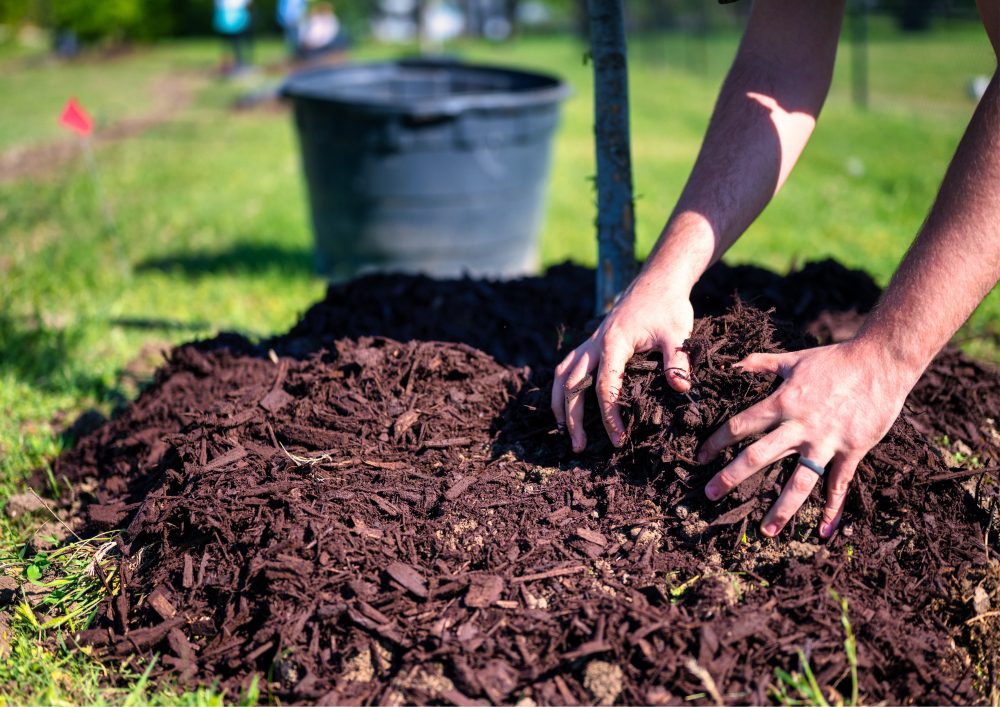
Wood Chips
Wood chips come from the bark of various trees like pine, cedar, and cypress. They are popular for their attractive appearance and long-lasting quality. On the plus side, wood chips gradually break down and enrich the soil. However, they can be expensive and may attract unwanted pests like termites.
Straw
Straw is made from dried stems of plants like wheat or barley. It’s a budget-friendly option often used in vegetable gardens. While it’s affordable and can help keep the soil moist, it also has downsides like attracting rodents and potentially harboring weed seeds.
Rubber Mulch
Rubber mulch is crafted from recycled tires and comes in various colors. It’s durable and stays put for years. But it’s more expensive than organic mulches and doesn’t contribute to soil health.
Cocoa Hulls
Cocoa hulls are the shells from cocoa beans. They have a pleasant chocolate aroma and also add nutrients to the soil. The downsides are they can be pricey and are toxic to dogs, so be cautious if you have pets.
Pine Needles
Pine needles are simply the fallen needles from pine trees. They work well for plants that prefer acidic soil. They’re often free if you have pine trees but are unsuitable for plants requiring neutral or alkaline soil.
Gravel and Stone
Gravel and stone are small rocks that provide good drainage and last indefinitely. They don’t enrich the soil and can get hot in the sun, which might not be ideal for some plants.
Coconut Husk
Coconut husk mulch is made from the outer shell of coconuts. It’s lightweight and good for retaining moisture. However, it can be expensive and might float away during heavy rains, so it’s not ideal for all garden types.
How to Apply
Once you have your mulch, here is how you use them for your plants:
- Clear the area of weeds and debris.
- Water the soil before mulching.
- Lay a fabric weed barrier if needed.
- Pour the mulch, starting from the garden edge.
- Spread it evenly with a rake.
- Keep mulch 2-3 inches away from plant stems.
- Use a 2- to 3-inch layer for best results.
How Much to Use
When it comes to mulch, more isn’t always better. Using the right amount is key. A layer of 2-3 inches is usually best for most gardens. This depth is enough to keep moisture in and weeds out but not so thick that it suffocates plants.
If you pile it too high against the base of your plants, you can cause rot. On the other hand, too little mulch won’t be effective. It won’t keep the moisture or control weeds well.
The right amount of mulch sets the stage for a healthy, low-maintenance garden that thrives with less water. To figure out how much you’ll need, measure your garden area and consult with experts or use online calculators.
When to Replace
Knowing when to replace mulch is crucial. Organic mulch types like wood chips and straw break down over time. Mulch is good for soil health but means you must replace it.
Usually, a yearly check is a good rule. Look for signs like fading color or thinning areas. Synthetic mulches like rubber don’t break down but can get blown away or scattered. These may need topping up less often but still need occasional replacement.
Replacing mulch keeps your garden looking fresh and functioning well. You maintain the benefits of moisture retention and weed control.
Benefits Beyond Moisture
Mulch does more than just hold in moisture. It offers several other benefits that can help your garden. One big plus is weed control. A solid layer of mulch makes it hard for weeds to break through.
Mulch also helps regulate soil temperature. It acts like a blanket that keeps soil warmer in winter and cooler in summer. Some types of organic mulch can also improve your soil. As they break down, they add valuable nutrients.
Let’s not forget mulch also adds a polished look to your garden. Its color and texture can complement your plants and overall design. All these benefits make mulch a smart choice for any garden, especially one that aims to be drought-tolerant.
Mulch does a lot of good for your garden. From retaining moisture to fighting weeds, it’s a garden must-have. Ensure you pick the right type and apply it correctly for the best results.
Maintenance
Maintaining a drought-tolerant garden is easier than you think. You can enjoy a lush space with the right steps without much fuss. Let’s dive into the essentials of garden upkeep.
Check for Pests
Even drought-tolerant gardens can get pests. Look for signs like chewed leaves or damaged stems. Ants and aphids are common culprits. Some pests are tougher to spot, like those in the soil.
Natural methods like introducing ladybugs can help control these bugs. Chemical pesticides work, too, but try to use them as a last resort. Pesticides can harm helpful insects and your soil. Regular checks will help you catch pests before they become a big problem.
Pruning and Deadheading
Keeping plants neat helps them grow better. Pruning means cutting back overgrown branches and leaves. It also helps the plant focus its energy on new growth. Deadheading is removing spent flowers.
Pruning makes room for new blooms. Both tasks help your garden look better and grow stronger. A pair of sharp garden shears is all you need. Aim to do this in late winter or early spring for most plants.
Fertilizing
Your soil gives plants most of what they need. But sometimes, they need an extra boost. That’s where fertilizer comes in. Organic options like compost are good choices. They improve soil structure and add nutrients.
Use fertilizer sparingly. Too much can harm plants and seep into waterways. Always follow the directions on the package. Some plants have special needs, so do a little research first.
Seasonal Cleanup
Each season brings new tasks. In spring, prepare your beds for planting. Summer is for weeding and watering. Fall is the time to remove dead plants and add mulch.
In winter, protect your plants from cold and frost. Seasonal cleanup helps your garden adapt to changing conditions. It’s a vital part of a healthy garden. A little work each season sets you up for a full year of success.
Regular Inspection
Regular inspections help you spot problems early. Then, you can fix them before they get worse. Think of it like a garden health check. It’s a simple but essential step in garden care.
Retaining Soil Quality
Good soil is the backbone of any garden. Over time, soil can lose nutrients. Adding organic matter like compost helps. Also, consider rotating your plants. Different plants use different nutrients. By switching places, they help the soil stay balanced.
Testing your soil every few years is also smart. Tests can tell you what your soil is missing so you can fix it. Keep your soil healthy, and your plants will thank you.
With these maintenance tips, your drought-tolerant garden will be a long-lasting success. It doesn’t require much work, just smart, consistent care. Now, go enjoy your beautiful, water-wise outdoor space!
Conclusion
As a home builder, you understand the value of efficiency and quality. This type of garden adds a unique selling point to your builds. It’s good for the environment and future homeowners’ wallets. Plus, it makes the outdoor space appealing and functional.
A well-planned, drought-tolerant garden boosts property value and buyer interest. It’s a win-win. So take these tips and make that dream garden a reality.






